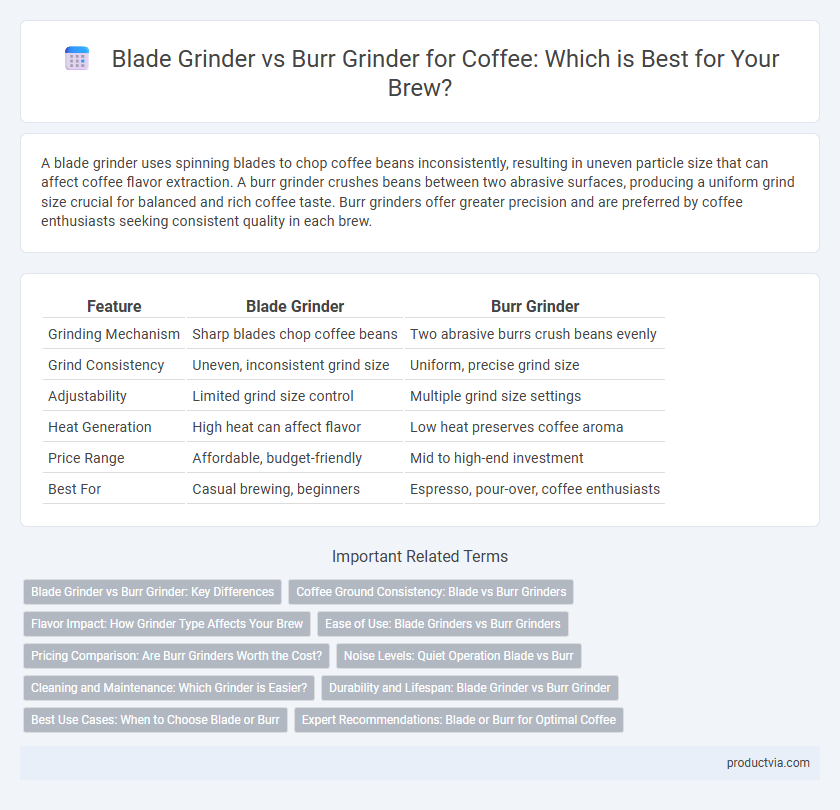A blade grinder uses spinning blades to chop coffee beans inconsistently, resulting in uneven particle size that can affect coffee flavor extraction. A burr grinder crushes beans between two abrasive surfaces, producing a uniform grind size crucial for balanced and rich coffee taste. Burr grinders offer greater precision and are preferred by coffee enthusiasts seeking consistent quality in each brew.
Table of Comparison
| Feature | Blade Grinder | Burr Grinder |
|---|---|---|
| Grinding Mechanism | Sharp blades chop coffee beans | Two abrasive burrs crush beans evenly |
| Grind Consistency | Uneven, inconsistent grind size | Uniform, precise grind size |
| Adjustability | Limited grind size control | Multiple grind size settings |
| Heat Generation | High heat can affect flavor | Low heat preserves coffee aroma |
| Price Range | Affordable, budget-friendly | Mid to high-end investment |
| Best For | Casual brewing, beginners | Espresso, pour-over, coffee enthusiasts |
Blade Grinder vs Burr Grinder: Key Differences
Blade grinders use spinning blades to chop coffee beans, resulting in inconsistent particle size that can affect extraction and flavor. Burr grinders crush beans between two abrasive surfaces, producing a uniform grind size that enhances brewing consistency and flavor clarity. The precision offered by burr grinders makes them ideal for coffee enthusiasts seeking optimal taste.
Coffee Ground Consistency: Blade vs Burr Grinders
Burr grinders deliver uniform coffee ground consistency by using two abrasive surfaces to crush beans, essential for optimal extraction and flavor balance. Blade grinders chop beans unevenly with a spinning blade, resulting in inconsistent particle sizes that can cause over-extraction or under-extraction. Precision in grind size from burr grinders enhances espresso quality, drip coffee, and French press brewing by ensuring stable extraction rates.
Flavor Impact: How Grinder Type Affects Your Brew
Blade grinders chop coffee beans unevenly, leading to inconsistent particle sizes that can cause over-extraction and a bitter taste in your brew. Burr grinders crush beans uniformly, producing consistent grounds that enhance flavor clarity and balance by ensuring even extraction. Choosing a burr grinder significantly improves the overall flavor profile and aroma of your coffee compared to blade grinders.
Ease of Use: Blade Grinders vs Burr Grinders
Blade grinders offer simplicity and speed, making them easy to operate for beginners with just a push of a button. Burr grinders provide more control over grind size, but their settings and slower grinding process can be less intuitive for casual users. Choosing between the two depends on whether convenience or precision is the priority for daily coffee preparations.
Pricing Comparison: Are Burr Grinders Worth the Cost?
Burr grinders typically range from $50 to over $300, offering consistent grind size essential for optimal coffee extraction, while blade grinders cost between $20 and $50 but produce uneven grounds that can result in bitter or weak flavors. Investing in a burr grinder enhances coffee quality and control, justifying the higher price for enthusiasts and daily brewers focused on taste precision. Budget-conscious buyers may prefer blade grinders for occasional use, but burr grinders provide superior long-term value through durability and grind consistency.
Noise Levels: Quiet Operation Blade vs Burr
Burr grinders operate at lower RPMs, producing significantly less noise compared to high-speed blade grinders, making them ideal for quiet coffee preparation. The consistent, uniform grinding action of burrs reduces motor strain and sound emission, enhancing the overall user experience. In contrast, blade grinders generate higher decibel levels due to rapid blade rotation and uneven particle crushing, often leading to louder, more disruptive noise.
Cleaning and Maintenance: Which Grinder is Easier?
Blade grinders have a simpler design with fewer parts, making cleaning quick but often less thorough due to uneven particle buildup around the blades. Burr grinders feature more components and require disassembly for deep cleaning, but their design prevents coffee residue from accumulating as easily, resulting in less frequent maintenance. Regular brushing and occasional wipe-down of burrs ensure optimal performance, while blade grinders may need more frequent cleaning to avoid stale coffee flavors.
Durability and Lifespan: Blade Grinder vs Burr Grinder
Burr grinders offer superior durability and a longer lifespan compared to blade grinders due to their robust construction and precision-engineered burrs that resist wear over time. Blade grinders, typically made with less durable materials and spinning blades, experience faster dulling and reduced grinding consistency. Investing in a burr grinder ensures consistent coffee grounds and reliable performance for years, making it a cost-effective choice for long-term use.
Best Use Cases: When to Choose Blade or Burr
Blade grinders are ideal for those seeking a budget-friendly option for occasional coffee brewing methods like drip or French press, where grind consistency is less critical. Burr grinders deliver uniform particle size, making them essential for espresso and pour-over techniques that require precise extraction and flavor control. Choosing between blade and burr grinders hinges on your brewing method, consistency needs, and investment in coffee quality.
Expert Recommendations: Blade or Burr for Optimal Coffee
Expert recommendations for coffee grinding consistently favor burr grinders over blade grinders for optimal flavor extraction; burr grinders offer uniform particle size, crucial for consistent brewing and balanced taste. Blade grinders often produce uneven grounds, leading to over-extraction or under-extraction and resulting in bitter or weak coffee. Coffee professionals emphasize burr grinders' adjustable grind settings, enabling precise control tailored to brewing methods like espresso, drip, or French press, which enhances overall coffee quality.
Blade grinder vs Burr grinder for coffee Infographic

 productvia.com
productvia.com